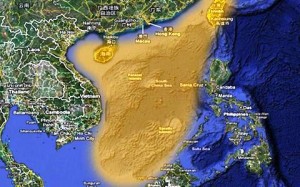by Norman Vasu*
 While the United States (US) government attempts to pivot towards Asia, China’s recent diplomatic and military moves suggests it is China who has the more robust and thoroughgoing strategy in the region. In effect, China’s latest moves leave the impression that the US pivot has become an aimless pirouette.
While the United States (US) government attempts to pivot towards Asia, China’s recent diplomatic and military moves suggests it is China who has the more robust and thoroughgoing strategy in the region. In effect, China’s latest moves leave the impression that the US pivot has become an aimless pirouette.
At the foreign ministers’ meeting in July this year, China displayed how it has effectively become a de facto member of the Association of Southeast Asian Nations (ASEAN) through its influence of Cambodia. As ASEAN requires a consensus on all its decisions, Cambodia stonewalled the release of a joint communique for the first time in ASEAN’s 45-year history by being unwilling mention the territorial disputes in the South China Sea.
At the ASEAN meetings and East Asia Summit concluded last week, China was once again accused of manipulating meeting chair Cambodia, with Cambodia initially stating that ASEAN had agreed not to “internationalize” the South China Sea dispute. Such an agreement would have suited China, who is wary of countries like the Philippines seeking US support over the issue. Though the move failed after objections by some ASEAN nations, Beijing’s strategy of keeping ASEAN divided in order to negotiate bilaterally with the weaker South East Asian claimant states continues to be both in play and in place.
When events at the ASEAN foreign ministers’ are considered alongside the developments at the ASEAN meetings and the East Asia Summit, it has been China who has displayed far more realpolitik nous in engaging with other states of the region. In place for a number of years, states such as Cambodia have been pulled into China’s orbit through large-scale economic investment – a strategy that the US has only recently taken on board.
Moreover, if cash has not bought enough friends for China, military might may be able to keep recalcitrants in line. Chinese state media has reported that the Chinese military has carried out its first successful landing of a self-produced J-15 fighter jet on its first aircraft carrier, the Liaoning. Reports suggest that another carrier could be completed by 2015. While the US military maintains that it will be years before China achieves a minimal level of combat capability for its aircraft carriers, these developments leave little ambiguity on the trajectory of Chinese military ambition – more powerful and farther force projection.
All in all, Chinese action in the region shows that it is outmaneuvering the US pivot. The pivot as it stands remains largely seen in Asia as either overly militarily focused – for example, the rotating of US marines in Darwin, Australia – or, empty rhetoric – as observed in the continued US urging for a diplomatic solution over disputed islands in the region rather than an expression of unequivocal support of its friends and allies involved in the dispute.
So what is an Asia-Pacific power to do? Arguably, besides playing catch-up with China’s economic diplomacy game and continuing to remain militarily present in the region, a good dose of public diplomacy is required to bring life back to the pivot. Besides economic and military might, painting a clear picture of how it sees Asia in the long run as well as the US’ continued place in it may go far. Such a move will shape the ideational imagination of the region – effectively over time moving states to understand and agree with the US vision and ideas for the region.
The “vision thing” after all may be China’s Achilles Heel in international relations. While adept at employing economic and military gravitas to persuade, China till now has been very poor at shaping the region’s ideational imagination – little is known of the ideals of China and how it sees Asia developing and progressing. By doing so, public diplomacy could usher a Copernican Revolution (of sorts) in understanding the relationship between the US and Asia. It can drive home the point that beyond might and money US will always be intimately tied to Asia in order for the U.S. — as well as its stated goal of continuing to be firmly embedded in the region — to remain relevant.
______________________
Dr. Norman Vasu is an Assistant Professor and Deputy Head of the Centre of Excellence for National Security, S. Rajaratnam School of International Studies, Nanyang Technological University, Singapore. He is currently a Fulbright Research Scholar and Visiting Fellow at the CSC.


